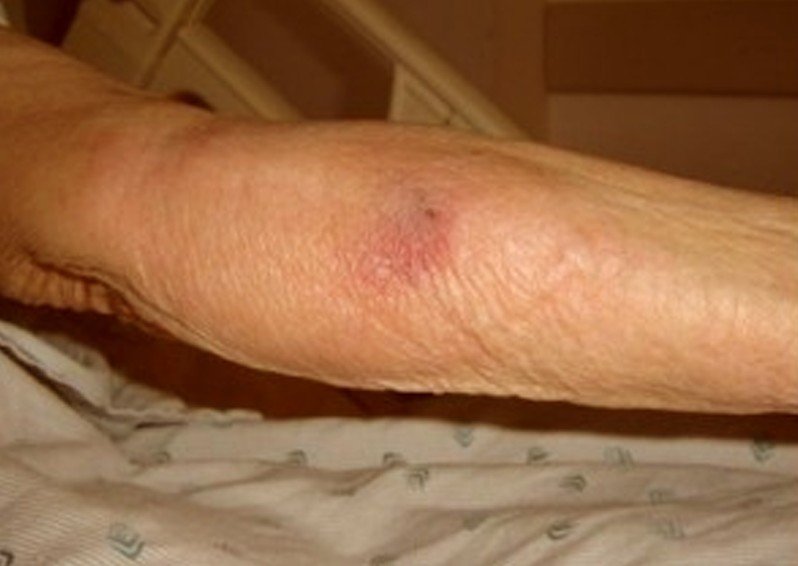Phlebitis
Last reviewed by Dr. Raj MD on January 12th, 2022.
What is Phlebitis?
This is the inflammation and swelling of the vein that usually has a small or large blood clot in the affected vein. It can be one or more clots. It is also known as thrombophlebitis of which there are two types with each type having their own symptoms. The blood clots are also known as thrombi.
Superficial phlebitis
Although this type will require medical attention it is not that severe. It affects the veins on the superficial layer of your skin.
Deep vein phlebitis or thrombosis (DVT)
This type can be life threatening because the clot(s) in your vein could break off and enter your bloodstream, which can cause a stroke. When the clot(s) travel to your lungs it is called pulmonary embolism. This type affects the deeper veins in your body.
Phlebitis Symptoms
Superficial phlebitis
- Swelling of your vein
- Redness, tightness and/or swelling of your skin around the affected vein
- Having a slight fever
- Having an uncomfortable or burning feeling around the affected vein
- May have itchy feeling
- As the inflammation grows up you may notice a thin long red line
These symptoms may worsen when you lower the limb, which is usually your leg or arm where these superficial veins are found. Some people notice these symptoms more when they first get out of bed in the morning. When a person has superficial phlebitis it is a slow process so many do not notice these symptoms at first.
Deep vein phlebitis or thrombosis
With this type of phlebitis there many not be any symptoms but if the case is severe you may notice these symptoms.
- In the limb where the affected vein is located you may notice discomfort and swelling of the whole limb.
- Fever
- Discomfort, burning, and tightening around your vein
- In the limb that is affected you may notice redness or redness around the vein that is affected.
Phlebitis Causes
The causes for either type of phlebitis are the same which can include:
- Sitting for a long period of time on a long trip such as in an airplane or car.
- Being obese
- Smoking
- Taking birth control pills
- Being pregnant
- Having a lifestyle that is inactive
- Having an injury to a vein that is traumatic
- Leg paralysis
- From intravenous therapy which is when you have a liquid medication directly passed into a vein can trigger phlebitis, especially if you need this type of therapy often such as in cancer patients
- Deficiency in your blood such as the deficiency of vitamin B-12 which prevents a clot from normally dissolving
- Surgery where you are required to be on bed rest for a long period of time
Although these are not exact causes, there are some risks that could cause a person to develop either type. Those at risk are transsexuals who are taking estrogen in order to maintain an appearance that is feminine or women who are on hormone replacement therapy. In addition, if you have had deep vein phlebitis or thrombosis in the past you are risk for developing a clot(s).
Phlebitis Treatment
Treatment for either type is extremely important. The type of treatment that is used will depend on the area that is affected, what symptoms you are having, and if you have any other medical conditions. If a person has deep vein phlebitis or thrombosis it is very important that the clot(s) in the vein are broken apart to prevent them from breaking loose and entering your bloodstream. They can be broken up in two different ways, which are:
- Medication that is passed into the vein(s) to break the clot up
- Being given oral medication that can help to prevent any further clot(s). One type of medication used is aspirin
Both of these treatments can be used on either type. Your physician may also recommend that you wear compression stockings or for you to take over-the-counter non-steroidal anti-inflammatory medications such as Ibuprofen. When a person has deep vein phlebitis or thrombosis you may have to be hospitalized and undergo surgery to get rid of the blood clot(s). If you are a smoker your physician will ask that you stop and also start to eat a healthy diet for your heart along with an exercise program and losing weight if you are overweight, especially if you are obese.
If you are taking birth control pill your physician will help you find an alternative form of birth control. If you are planning a long car trip you should stop every couple of hours to stretch your legs. On a long plane trip you should get up and move around every once in a while. Doing this will help to make sure that you do not have any clots form in your legs. If you have the superficial phlebitis type you need to find out what is the cause so you can fix the problem so it will not progress into deep vein phlebitis or thrombosis.
It may also help when you sit to keep your leg elevated. Your physician may also tell you to use a heating pad on it, especially if it is superficial phlebitis. In addition to breaking up the clot(s) your physician may also prescribe a blood thinning medication.
Phlebitis Pictures
Collection of Phlebitis pictures…




